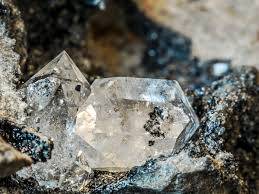Here are some things to look for while identifying raw diamonds.
1. Concentrate On Gravity
If you’re looking for a rough diamond, you should be aware of its specific gravity. The density of a diamond varies between 3.5 and 3.53 g/ml, which is the ratio of the stone’s density to a pure liquid with a thickness of 1 g/ml. However, this gem’s identification should not be confused with quartz with a gravity of 2.6 to 2.7.
With this gravity, separating the raw diamond from other diamonds is simple.
2. Perform a thermal absorption test
Diamonds are the best heat absorbers of all gemstones. Diamond testers can be used to validate this on your stone. These hand-held instruments have a metal head that makes contact with the diamond under test. It generates a little quantity of heat and measures how quickly the stone absorbs it.
3. Perform a toughness test
Every diamond, whether rough or polished, is the toughest gemstone known to man. On the Mohs scale of hardness, which ranks minerals from softest to hardest, this diamond receives the highest grade.
4. Perform an ultraviolet (UV) light test
Under shortwave ultraviolet light, 30% of diamonds glow blue. It will occur once you place a diamond under ultraviolet light. However, some will shine and generate different colours, such as yellow, red, or orange, making this procedure not 100% accurate
Crystal Structure
Raw diamonds typically exhibit an octahedral crystal structure, characterized by eight triangular faces. This distinctive structure contributes to their unique optical properties.
Surface Texture
Raw diamonds often have a rough and textured surface, resembling a pebble or rock. This texture is a result of their natural formation process.
Luster
Raw diamonds display a glassy or adamantine luster. When held under light, they exhibit a brilliant shine that sets them apart from surrounding rocks.
Color
Raw diamonds can come in various colors, ranging from colorless to shades of yellow, brown, and even rare hues like blue and green. However, colorless or near-colorless raw diamonds are highly sought after.
Transparency
Raw diamonds may appear translucent to opaque due to the presence of internal and external inclusions. Inclusions are often natural minerals or imperfections that give each diamond a unique identity.
Inclusions
The presence of visible inclusions, known as “inclusions within,” is common in raw diamonds. These inclusions are often surface-reaching or found deep within the diamond.
Refraction
Raw diamonds exhibit strong refraction, which causes light to bend and reflect within the diamond’s interior.
This contributes to their remarkable sparkle.
Hardness
Diamonds are the hardest natural material, ranking 10 on the Mohs scale. A simple hardness test can be conducted using a piece of corundum (hardness of 9) to scratch the surface of the diamond. If the diamond scratches the corundum, it is likely a genuine diamond.
Weight
Raw diamonds are usually sold by weight in carats. A digital scale can be used to measure the weight of the diamond, providing valuable information for identification.
Density
Diamonds have a relatively high density compared to most other minerals. You can test this by using water displacement to measure the diamond’s volume and calculate its density.
Fluorescence
Exposing a raw diamond to ultraviolet (UV) light can reveal its fluorescence. Most diamonds emit a blue fluorescence under UV light.
Professional Evaluation
For an accurate identification, it’s recommended to seek the expertise of a gemologist or a certified appraiser. These professionals have the tools and knowledge to assess the authenticity and quality of a raw diamond. That is how to identify a raw diamond.
Remember
Identifying raw diamonds requires training and experience.
Be cautious of potential imitations or synthetic diamonds, which may closely resemble raw diamonds.
If you’re considering purchasing a raw diamond, ensure you buy from reputable sources and request certification if available.
Identifying raw diamonds is a blend of science, observation, and appreciation for the wonders of nature. Whether you’re a gem enthusiast or considering purchasing a raw diamond, developing a discerning eye will enhance your understanding of these exquisite gems.


